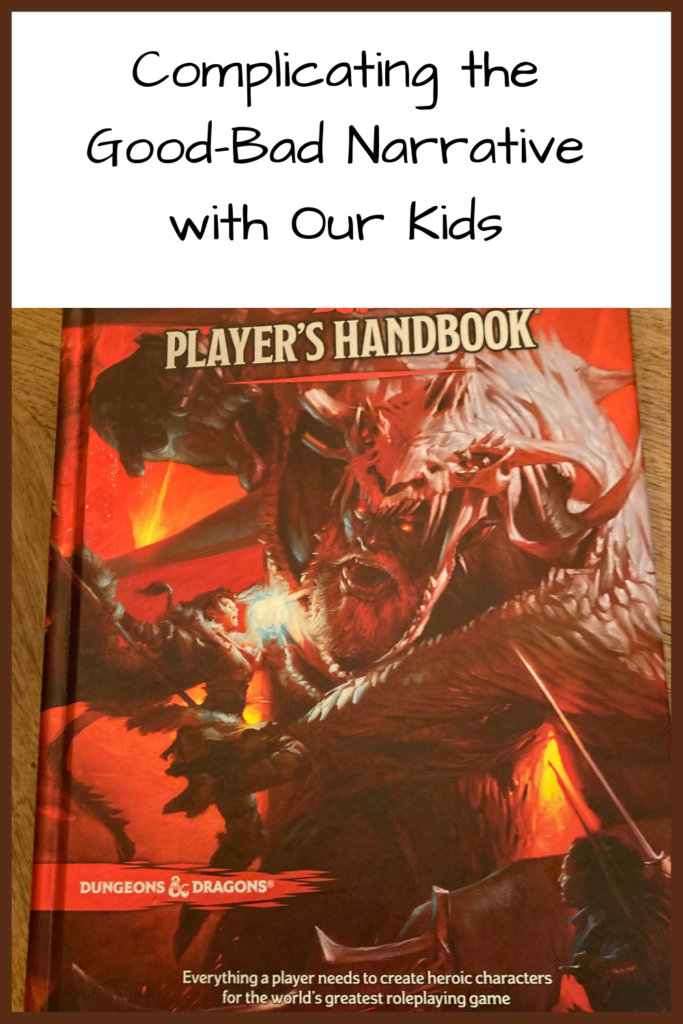
“So Bowser would be chaotic evil, right?” my older son asked as we sat on our front steps, referring to the villain of his favorite Mario Bros video games.
“Hmmm, I think so. He just wants to cause chaos and hurt people rather than follow any laws while doing so. Maybe neutral evil,” I replied, talking in terms of the alignment chart from Dungeons and Dragons.
My husband and I are tabletop role-players and have been for years. We’ve even played a simplified version with our kids and they love to hear the stories of our “adventures.” While the alignment chart – which breaks everyone down into a spectrum from good to neutral to evil and lawful to neutral to chaotic and every combination thereof – is overly simplified, it’s still a hell of a lot more complex than the “good guys” and “bad guys” dichotomy most media for younger children presents. After all, most kids’ shows or books don’t examine what it means to be good or bad. Good is following the rules, unless you’re a superhero who is allowed to ignore the rules because no ever mentions them. (I’m pretty sure the PJ Masks have broken loads of rules but the only consequence they ever face is fighting in a way that lets the villain get away until the end of the episode.) Bad is whoever the show tells us is bad.
What I like about the D&D alignments is that it adds in the lawful to chaotic aspect.
My kids are inherently chaotic, even a little more than most kids. They’re anti-authoritarian, loud, messy, bouncing-off-the-walls, hyper, and just A Lot. They find it challenging to stay still, be quiet, pay attention, and follow directions, even more than other kids their age. Our society generally tells kids with these traits that they’re “bad.” That there’s something wrong with them or that they aren’t trying hard enough to be “good.” That they’re broken. I’ve struggled with this point of view myself, as a kid who was so rule-bound that I would tell on myself when I broke a rule. So to point out to my kids they there is a “chaotic good” option – that someone can be good because they’re chaotic, not in spite of it – is refreshing.
I also like how the alignment chart decouples being “lawful” – rule-following – from good. We’ve talked to our kids about how it can be a good thing to purposefully break the rules, if the rules are consistently unfair to the same people or reinforce injustice. Books featuring people in the Civil Rights and other social justice movements who participated in civil disobedience have a prominent place on our bookshelves.
On the flip side, it introduces the idea that people can follow all of the laws and use them for evil. Or even create systems and laws to be purposely evil. As our systems are built on a foundation of white supremacy, racism, classism, ableism, and overall kyriarchy (intersections of systems of power and oppression) and society teaches us otherwise, this perspective is straight-up counter-cultural. Kids with privilege like mine will be more likely to see systems as fair and unproblematic – because they’re benefitting from them. It’s hard to question things that benefit you. But if we talk about from the beginning how systems are built to benefit some people over others and that’s fundamentally wrong, then our kids will have the tools to psychologically and practically manage making change.
While most people may not play D&D with their kids or have reasons to discuss the alignment chart, it’s just one way we use the interests of our kids to spark and deepen conversation. “Deep” conversations aren’t one and done. Instead, opportunities arise to have these conversations over and over again. We just have to keep our eyes and ears open so we can see and take them as they arise.